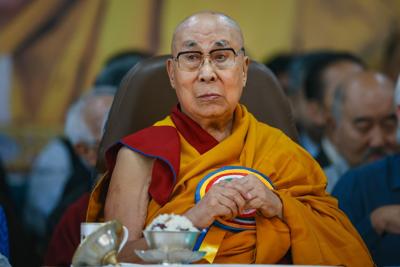This week, the Dalai Lama marked his 90th birthday celebration with a lamentation. And a proclamation:
His Holiness has opted for the ancient tradition of reincarnation.
For years, he had left open the question of succession, musing about the possibility of naming an adult heir instead of a child chosen after his death. Now, the matter has been settled spiritually, yet much remains unsettled politically.
The Dalai Lama is revered and renowned, but his reincarnation is also a life and death question for the Tibetan nation. For in the eyes of the world — everywhere but the People’s Republic of China — the Dalai Lama is seen as the incarnation of Tibetan Buddhism, the embodiment of political hopes and spiritual aspirations.
After he is gone, who will make the world listen? The answer, it seems, is that the 14th Dalai Lama will be back, albeit in another body, when the time comes.
Can Tibet wait that long for a comeback? What if there are rival reincarnations, pitting a preferred Tibetan nomination against China’s own choice?
If the past is any guide, the ritual of selection for any reincarnation will be rife with complications.
This is not a matter of merely awaiting the white smoke signals when cardinals assemble in the Vatican to choose a new pope. Tibetan succession involves search parties looking for holy traits, consulting astrology, heeding oracles, relying on mystical visions and seeking clues left by the last Dalai Lama.
Above all, it takes time — not only for the search and selection of a child, but also for the education and coming of age of a spiritual leader. That would leave Tibet in limbo for years to come.
When the 14th Dalai Lama was discovered by a search party of eminent monks and disciples in 1935 among a family of peasants in the remote northeastern Tibet (now Qinghai Province in China) he was two years old. The search itself took two years.
Educated by monks and groomed for greatness, he assumed the mantle of leadership at age 16 in Tibet’s hour of need, after Mao Zedong’s Red Army invaded in 1950. After a 1959 uprising over China’s occupation, the Dalai Lama escaped in disguise on horseback, seeking refuge in the Indian town of Dharamsala.
From his perch in the Himalayas, he kept trying to bridge the gap with China’s Communist rulers, talking of a Buddhist-style “middle path” offering a compromise of Tibetan “autonomy” within a sovereign China — its territorial integrity intact. Decades of negotiations came to naught.
If the two sides still cannot agree on co-existence, there seems little likelihood that Beijing will respect the integrity, complexity and spirituality of reincarnation. We have seen this before.
Upon the death in 1989 of the 10th Panchen Lama — the second-highest spiritual figure in Tibetan Buddhism — the Dalai Lama named a five-year-old to succeed him. The boy and his family were whisked away by the Chinese authorities who named their own loyalist monk to be the 11th Panchen Lama.
Such is the conundrum for Kundun — the Presence, as he is known to disciples.
The Dalai Lama is considered a living god by his followers, the Wish-Fulfilling Gem. His official title translates as “Holy Lord, Gentle glory, Eloquent, Compassionate, learned Defender of the Faith, Ocean of Wisdom.”
The Dalai Lama is empowered by Tibet’s remarkable culture, but also encumbered by it. Reincarnation is a time-consuming ritual, and the education of the chosen monk takes even more time, precisely when China’s avowedly-atheist Communist Party is threatening to exploit any delay or power vacuum to maximize its own advantages.
Perhaps that is why the Dalai Lama has tried so hard to modernize and democratize Tibetan political culture. Over the past quarter-century he has delegated his political powers to an elected assembly and government-in-exile, while focusing on his spiritual role.
When I interviewed him nearly two decades ago in his heavily guarded hilltop residence-in-exile in Dharamsala, India, the Dalai Lama was already weighed down by the challenges posed by China and the march of time — not just for him, but his people.
“The Tibetan nation is dying, so therefore we need (an) immediate future,” he said back then, sitting in his crimson robes surrounded by thangkas — painted Buddhist scrolls on the walls. He warned of a “cultural genocide” as China overwhelmed the capital city of Lhasa with economic might and the power of assimilation.
China’s propaganda machine has denounced him as a “jackal” and a “reactionary, feudal serf-owner.” Cocking his head and chortling in laughter, he described his favourite insult: “Wolf in monk’s clothing.”
But he turned serious as he tried to find the middle way: “I am not seeking independence. This is my mantra! You know mantra? A thousand times you should recite that.”
The Dalai Lama was 70 when he repeated that mantra to me. Now he is 90.
He has mused in the past that he might live until 110. This week, he updated that timeline to say he might wait until 130 before any initiation of reincarnation.
Perhaps the Wish-Fulfilling Gem is buying time. Happy birthday, Your Holiness.
Error! Sorry, there was an error processing your request.
There was a problem with the recaptcha. Please try again.
You may unsubscribe at any time. By signing up, you agree to our and . This site is protected by reCAPTCHA and the Google and apply.
Want more of the latest from us? Sign up for more at our newsletter page.



























To join the conversation set a first and last name in your user profile.
Sign in or register for free to join the Conversation